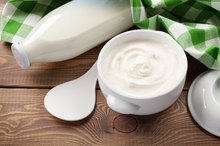The Differences Between Caplets and Capsules
Capsules and caplets are pharmaceutical products that deliver measured doses of medication to patients. Capsules are made of gelatin or plant-based material and contain medication in a form that provides an effective delivery mechanism. Caplets are tablets that are specially shaped, usually in the same shape as a capsule, and coated with a waxy layer. Capsules and caplets are both designed to be easy to swallow. They differ in the rate at which the patient's system absorbs the medication, and in the speed with which the medication is released.
Capsules
Capsules are made from gelatin, which is an animal-derived material, or from starch hydrolysate or methyl cellulose, which are plant-based. Some capsule shells are made from two halves that fit into each other to form a sealed capsule. This allows for mixes of medications and combinations that are not possible in caplet form. Some capsules are made from a sealed hard gelatin cap. These can contain oils and fat-soluble medications, and the sealed capsule prevents external elements from acting upon the contents. The shell of a capsule normally opens in about four minutes, allowing rapid absorption of the medication.
- Capsules are made from gelatin, which is an animal-derived material, or from starch hydrolysate or methyl cellulose, which are plant-based.
- These can contain oils and fat-soluble medications, and the sealed capsule prevents external elements from acting upon the contents.
Disadvantages of Capsules
Drugs Used in Nebulizers
Learn More
Capsules tend to be bulky, and they can prove difficult to swallow for some persons. The soft shell can dissolve into the contents and react with the medications. The nature of the soft shell makes it vulnerable to moisture damage and limits the contents to certain pH ranges. Capsules cause allergic reactions in some people, and animal-derived gelatin poses various ethical and nutritional challenges.
- Capsules tend to be bulky, and they can prove difficult to swallow for some persons.
Caplets
Caplets are formed by combining medications with a binding material and then compressing the mixture, under great pressure, into a capsule shape. They are normally coated with a film or gelatin to mask the taste of the ingredients and to make them easier to swallow. The rate at which a caplet dissolves is controlled by the type of binding agent used. Caplets can dissolve quickly in the stomach acids or over a long period, through a process known as extended release. Caplets can be notched or split to deliver lower dosages, and they often are cheaper than capsules. They tend to be well-tolerated by patients.
- Caplets are formed by combining medications with a binding material and then compressing the mixture, under great pressure, into a capsule shape.
- They are normally coated with a film or gelatin to mask the taste of the ingredients and to make them easier to swallow.
Disadvantages of Caplets
Nyquil Liquicap Ingredients
Learn More
The compact nature of caplets makes them harder to dissolve than capsules. Heat and moisture introduced during processing can affect the medications. Some patients are allergic or sensitive to the materials used to coat caplets. Some patients bite or chew on caplets before swallowing, which can affect the rate of dissolution and absorption of the medication.
- The compact nature of caplets makes them harder to dissolve than capsules.
- Some patients bite or chew on caplets before swallowing, which can affect the rate of dissolution and absorption of the medication.
Related Articles
References
Writer Bio
Gissimee Doe has been writing for over 11 years on a range of subjects and interests. Her favorite genres are horror, science fiction, adventure and food. Doe maintains a number of fashion and style blogs and is currently working on her first novel. She holds a Bachelor of Science in computer science and a Master of Science in computer-based management information systems.









